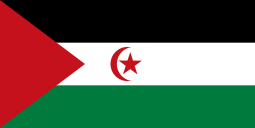Pan-Arab colors
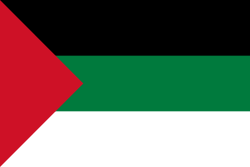
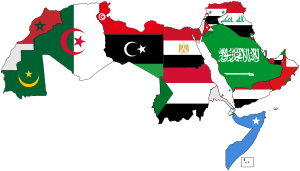
The Pan-Arab colors are black, white, green, and red. Individually, each of the four Pan-Arab colors were intended to represent a certain Arab dynasty, or era.[3] The black was the color of the banner of Muhammad and the Rashidun Caliphate and was later adopted by the Abbasid Caliphate; white was used by the Umayyad Caliphate; green was used by the Fatimid Caliphate; and red was both the flag held by the Khawarij and also represented the Hashemites, as well as the Ottoman Empire.[4] The four colors derived their potency from a verse by 14th century Iraqi poet Safi Al-Din Al-Hilli: "White are our acts, black our battles, green our fields, and red our swords".[5]
Pan-Arab colors were first combined in 1916 in the flag of the Arab Revolt.[6] Many current flags are based on Arab Revolt colors, such as the flags of Jordan, Kuwait, Palestine, the Sahrawi Arab Democratic Republic, and the United Arab Emirates,[7] and formerly in the flag of the brief six month union of the Arab Federation of Iraq and Jordan.
From the 1950s onwards, a sub-set of the Pan-Arab colors, the Arab Liberation colors, came to prominence. These consist of a tricolor of red, white and black bands, with green given less prominence. The Arab Liberation colors were inspired by the use of the Arab Liberation Flag in the Egyptian Revolution of 1952.[8] These appear in the current flags of Egypt, Iraq, Sudan, Syria, and Yemen, and formerly in the flags of the rival states of North Yemen and South Yemen, and in the short-lived Arab unions of the United Arab Republic and the Federation of Arab Republics.[7]
Current flags with Pan-Arab colors
UN member and observer sovereign states
Unrecognized and partially recognized states
Former national flags with the Pan-Arab colors

 OET Administration (1918–20)[13]
OET Administration (1918–20)[13].svg.png)

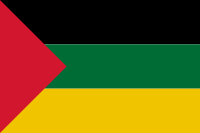 Emirate of Jabal Shammar (1920–21)[14]
Emirate of Jabal Shammar (1920–21)[14]
.svg.png)
 Hejaz (as part of the Kingdom of Nejd and Hejaz, 1926–32)
Hejaz (as part of the Kingdom of Nejd and Hejaz, 1926–32)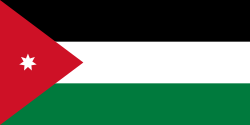
.svg.png) Syria (1932–58 and 1961–63),[13] used currently (2011 onwards) by the Syrian Interim Government and the Free Syrian Army
Syria (1932–58 and 1961–63),[13] used currently (2011 onwards) by the Syrian Interim Government and the Free Syrian Army
.svg.png)
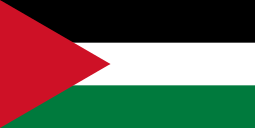
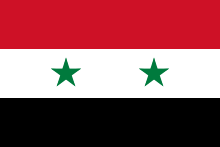 United Arab Republic (1958–61), Egypt (1961–72)
United Arab Republic (1958–61), Egypt (1961–72).svg.png) Iraq (1959–63)
Iraq (1959–63)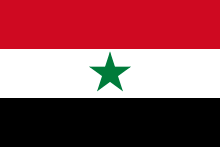 North Yemen (1962–90)
North Yemen (1962–90)%3B_Flag_of_Syria_(1963%E2%80%931972).svg.png)
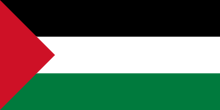
 Flag of Hadhramaut (1967–69)
Flag of Hadhramaut (1967–69)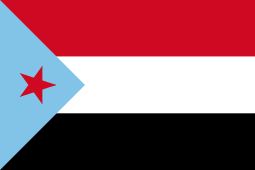 South Yemen (1967–90), used currently (2007 onwards) by the South Yemen Movement
South Yemen (1967–90), used currently (2007 onwards) by the South Yemen Movement.svg.png) Libya (1969–72)
Libya (1969–72).svg.png)
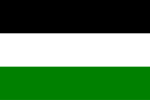
 Mahra Sultanate (unknown–1967)
Mahra Sultanate (unknown–1967).svg.png) Arab Islamic Republic (proposed 1974, never implemented)
Arab Islamic Republic (proposed 1974, never implemented).svg.png)
.svg.png) Iraq (2004–08)[19]
Iraq (2004–08)[19]
Flags of Arab political and paramilitary movements using Pan-Arab colors
- Flag of Ottoman era Istanbul-based autonomist "Arab Literature Club" (1909–15), a precursor Arab flag[20]
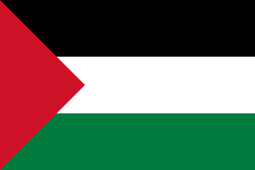 Flag of the Ba'ath Party (1947–present), also used by the National Democratic Front for the Liberation of Oman and the Arabian Gulf (active 1969–71)
Flag of the Ba'ath Party (1947–present), also used by the National Democratic Front for the Liberation of Oman and the Arabian Gulf (active 1969–71)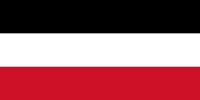 Flag of the National Liberation Front of Yemen (1963–78), the Dhofar Liberation Front (1965–68), and the Popular Front for the Liberation of the Occupied Arabian Gulf (1968–74)
Flag of the National Liberation Front of Yemen (1963–78), the Dhofar Liberation Front (1965–68), and the Popular Front for the Liberation of the Occupied Arabian Gulf (1968–74) Flag of the Popular Front for the Liberation of Oman (1974–92)
Flag of the Popular Front for the Liberation of Oman (1974–92)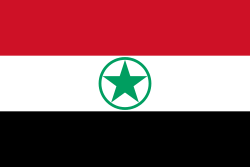
 Flag used by the separatist organisations the National Council of Ahwaz and the National Liberation Movement of Ahwaz in Khuzestan, Iran[22][23]
Flag used by the separatist organisations the National Council of Ahwaz and the National Liberation Movement of Ahwaz in Khuzestan, Iran[22][23] Flag of the Arab Movement of Azawad (2012–present)
Flag of the Arab Movement of Azawad (2012–present) Flag of Arab Jerusalem
Flag of Arab Jerusalem
Historical Arab flags


 Green dynastic color, used by the Fatimids [26]
Green dynastic color, used by the Fatimids [26]
See also
References
- 1 2 Pan-Arab Colors, crwflags.com
- ↑ Mahdi Abdul-Hadi. "The Great Arab Revolt". passia.org (in Arabic). Archived from the original on 2014-05-05.
- ↑ Abū Khaldūn Sati' al-Husri, The days of Maysalūn: A Page from the Modern History of the Arabs, Sidney Glauser Trans., (Washington D.C.: Middle East Institute, 1966), 46.
- ↑ Mahdi Abdul-Hadi, Palestine Facts: The Meaning of the Flag Archived 2012-04-19 at the Wayback Machine., passia.org
- ↑ Muhsin Al-Musawi, Reading Iraq: Culture and Power in Conflict (I. B. Tauris 2006), p. 63
- ↑ I. Friedman, British Pan-Arab Policy, 1915–1922, Transaction Publ., 2011, p.135
- 1 2 Znamierowski, Alfred (2003). Illustrated Book of Flags. Southwater. p. 123. ISBN 1-84215-881-3. Retrieved 22 November 2014.
The designs of these flags were later modified, but the four pan-Arab colors were retained and were adopted by Transjordan (1921), Palestine (1922), Kuwait (1961), the United Arab Emirates (1971), Western Sahara (1976) and Somaliland (1996).
- ↑ M. Naguib Egypt's Destiny 1955
- ↑ "Pan-Arab colors". www.abysse.co.jp.
- ↑ "Palestinian Law No. 5 for the year 2006 amending some provisions of Law No. 22 for the year 2005 on the Sanctity of the Palestinian Flag". Muqtafi.birzeit.edu. Retrieved 26 December 2014.
- ↑ Also used as the flag of Fujairah since 1975
- 1 2 Kingdom of Hejaz 1915–1925, Crwflags.com
- 1 2 3 4 5 Historical Flags Overview (Syria), Crwflags.com
- ↑ Ha'il (Saudi Arabia) – Emirate of 'Ha'il, Crwflags.com
- 1 2 Historical Flags (Jordan), Crwflags.com
- ↑ Kingdom of Iraq (1924–1958), Crwflags.com
- 1 2 Historical Flags (Palestine) , Crwflags.com
- ↑ Arab Federation of Jordan and Iraq, Crwflags.com
- 1 2 3 Evolution of the Iraqi Flag, 1963–2008, Crwflags.com
- ↑ Mahdi Abdul-Hadi, Al-Muntadha al-Adhabi Archived 2014-05-05 at the Wayback Machine., passia.org
- ↑ Mahdi Abdul-Hadi, Jam'yiat al-'Arabiya al-Fatat Archived 2014-05-05 at the Wayback Machine., passia.org
- 1 2 Al-Ahwaz (Khuzestan) Political Organizations (Iran) on crwflags.com
- ↑ S. T. Al-Seyed Naama, Brief History of Ahwaz, on al-ahwaz.com
- ↑ The contrast of white vs. black as the Fatimid/Umayyad vs. Abbasid dynastic colour over time developed in white as the colour of Shia Islam and black as the colour of Sunni Islam: "The proselytes of the ʿAbbasid revolution took full advantage of the eschatological expectations raised by black banners in their campaign to undermine the Umayyad dynasty from within. Even after the ʿAbbasids had triumphed over the Umayyads in 750, they continued to deploy black as their dynastic colour; not only the banners but the headdresses and garments of the ʿAbbasid caliphs were black [...] The ubiquitous black created a striking contrast with the banners and dynastic color of the Umayyads, which had been white [...] The Ismaili Shiʿite counter-caliphate founded by the Fatimids took white as its dynastic color, creating a visual contrast to the ʿAbbasid enemy [...] white became the Shiʿite color, in deliberate opposition to the black of the ʿAbbasid 'establishment'." Jane Hathaway, A Tale of Two Factions: Myth, Memory, and Identity in Ottoman Egypt and Yemen, 2012, p. 97f.
- ↑ The Abbasid Revolution against the Umayyad Caliphate adopted black for its rāyaʾ for which their partisans were called the musawwids. Tabari (1995), Jane McAuliffe, ed., Abbāsid Authority Affirmed, 28, SUNY, p. 124
- ↑ "Green is frequently found in Arab flags because this colour was taken by the Fatimite dynasty, which ruled most of north Africa." American Educator, New York, 1973, 7th vol., p. 131,
- ↑ Patricia Crone (2012). The Nativist Prophets of Early Islam. p. 122. .
External links
- Pan-Arab colors
- Evolution of the Arab Flag, by Dr. Mahdi Abdul-Hadi (in Arabic)





.svg.png)




